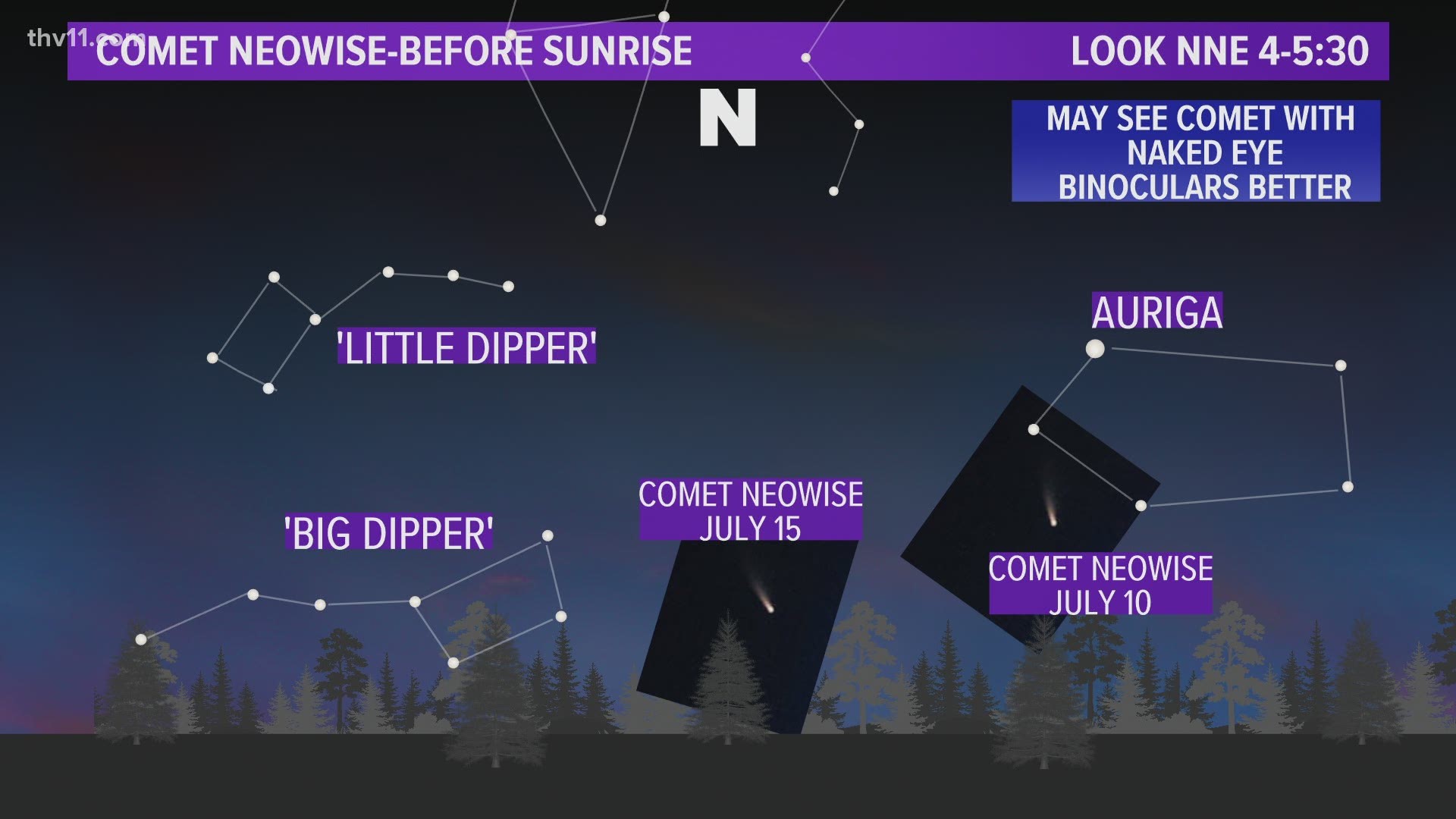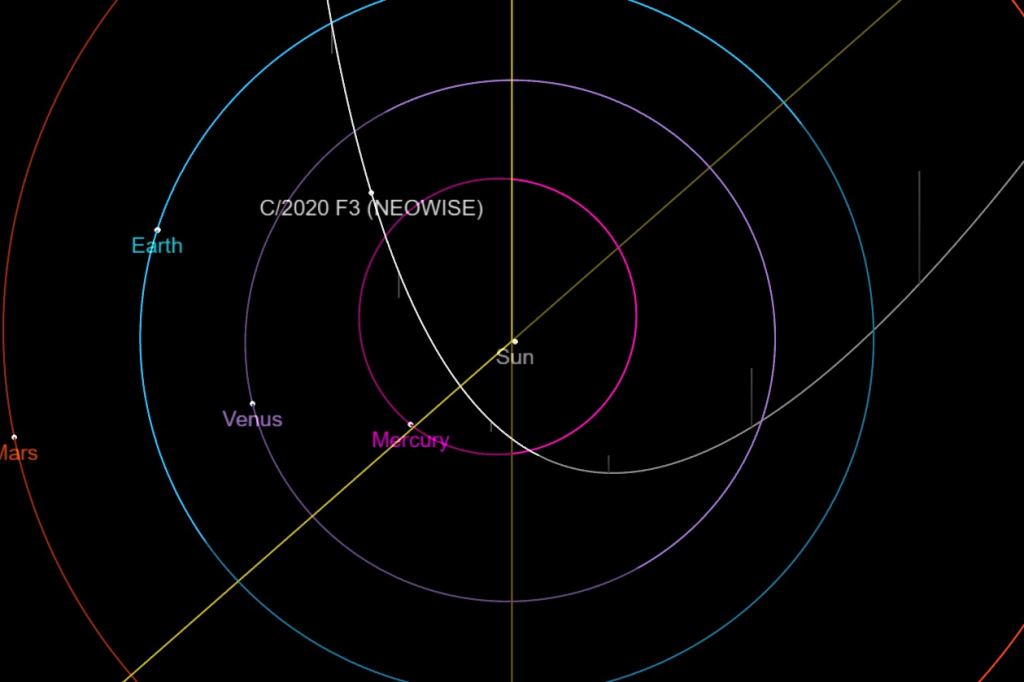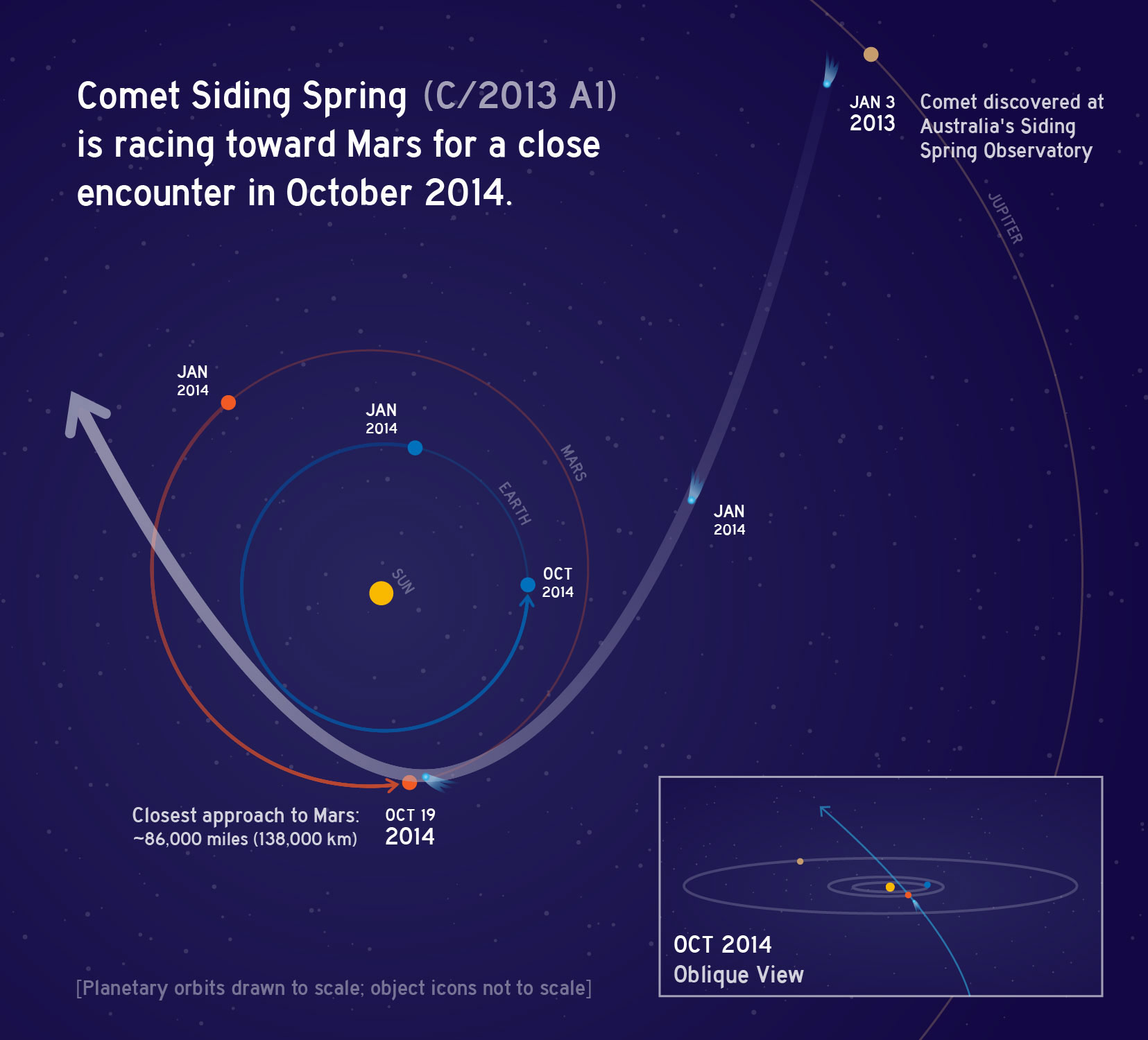Comet NEOWISE July 11, 2020 4:20 am PDT from Weed, California
Comet NEOWISE (aka C/2020 F3) was discovered on March 27 by astronomers during the NEOWISE mission, which used NASA's Wide-field Infrared Survey Explorer (WISE) space telescope to look for near. Because of the comet's extremely elliptical orbit, it will slow down as it reaches its farthest point from the sun, then fall back toward the inner solar system and accelerate again when it heads. Comet NEOWISE retrograde orbit crossed to the north of the plane of the ecliptic, to which it is inclined at approximately 129 degrees, on June 29, 2020, 01:47 UT. It made its closest approach to the Sun (perihelion) on July 3, 2020, at a distance of 0.29 AU (43 million km; 27 million mi). Visualization of Comet C/2021 A4 (NEOWISE) Orbit This 3d orbit diagram is a feature of our 3D Solar System Simulator and shows the orbit of Comet C/2021 A4 (NEOWISE) with respect of the Sun and the orbits of the major planets.

Comet C/2020 F3 (NEOWISE) survived a close pass (within the orbit of Mercury) with the Sun over the 4th of July weekend. It is bright enough for the unaided eye. Its long tail looks even better in binoculars.
The comet is visible while it is above the horizon and the Sun is sufficiently below the horizon to darken the sky enough to see the dim comet. This is before nautical dawn or after nautical dusk when the Sun is 12º below the horizon.
The comet rises in the northeast two hours before the Sun and sets with the Sun around 8:30 p.m. Look for a point of light with a fuzzy tail extending up and slightly to the left. Comet tails point away from the Sun.

The best time to look in Alabama this weekend is just before 4:00 am when it is very low on the horizon and 4:45 a.m. The earlier you look, and darker your skies the brighter the comet will be. The clearer your northeastern horizon, the earlier you can look.
As the comet continues to travel away from the Sun, it will become more visible in the evening, low on the northwestern horizon. Don’t delay in seeing it though, it is also expected to dim significantly over the coming week.
| date | morning low on NE horizon | evening low on NW horizon |
|---|---|---|
| 7/11 | 3:51 AM – 4:32 AM reaches 5.4° above horizon | not visible |
| 7/12 | 3:51 AM – 4:26 AM reaches 4.4° above horizon | not visible |
| 7/13 | 3:53 AM – 4:21 AM reaches 3.3° above horizon | 9:26 PM – 9:36 PM appears 1.0° above horizon |
| 7/14 | 3:57 AM – 4:15 AM reaches 2.0° above horizon | 9:31 PM – 9:56 PM appears 2.6° above horizon |
| 7/15 | 4:04 AM – 4:10 AM reaches 0.7° above horizon | 9:37 PM – 10:17 PM appears 4.2° above horizon |
| 7/16 | not visible | 9:43 PM – 10:37 PM appears 5.7° above horizon |
| 7/17 | not visible | 9:49 PM – 10:56 PM appears 7.1° above horizon |
Category: ALL POSTS, Spacey Stuff
Neowise Comet Orbit
Comets are solar system objects made up of ice, rock and dust. Right now, a newly-discovered one is speeding by Earth, providing excellent light shows for the planet’s people.
The ice-rock is called Neowise. It is the brightest comet to appear above the Northern Hemisphere in 25 years. Social media users in many countries have posted images they captured of Neowise, as it lit up the sky over their heads.
Comets are normally about 8 to 16 kilometers wide. But, as they travel near the sun, they heat up, releasing gas and dust. The comet expands to form a “glowing head that can be larger than a planet,” says the U.S. space agency NASA. The process also creates a sunlit “tail” of dust. It can stretch for millions of kilometers behind the comet.
Scientists say Neowise is believed to be about 5 kilometers across. It passed inside Mercury’s orbit on July 3, NASA’s Jet Propulsion Laboratory said in a statement. The close pass by the sun was “cooking” the comet’s outermost parts, causing a major release of gas and dust material. “And yet the comet has managed to survive this intense roasting,” the statement said.
The comet was named for NASA’s NEOWISE infrared space telescope, which discovered it in March. The NEOWISE project aims to search the skies for what scientists call near-Earth objects, or NEOs. Such objects include asteroids and comets that could come within 50 million kilometers of Earth’s orbit.
In this case, NASA said Neowise would pass by Earth “at a harmless distance of 103 million kilometers,” while giving astronomers a good chance to study its substance and structure.
Sky watchers may be able to see Neowise as it passes through the inner solar system. But “its nearness to the sun” could make sighting it difficult, NASA says.
Experts say people in the Northern Hemisphere - the part of Earth above the equator - should look toward the northwestern sky, just below the “Big Dipper” star group.

Until recently, the best time to see Neowise was about an hour before sunrise. This week, the comet began making its appearance in the evening sky shortly after sunset.
People have been able to see the head of the comet without the use of equipment. But devices like binoculars and telescopes are better for viewing the comet’s long tail.
Neowise is expected to be seeable across the Northern Hemisphere until mid-August. It will then start making its way back to the outer parts of the solar system.

NASA says it will be about 7,000 years before the comet returns. “So I wouldn’t suggest waiting for the next pass,” said Joe Masiero of NASA’s Jet Propulsion Laboratory.
Astronauts on the International Space Station caught a good look at the bright ice-rock last week. NASA’s Bob Behnken captured an image of Neowise and shared the picture on social media.
It shows central Asia in the background, and part of the space station in the foreground. “Stars, cities, spaceships, and a comet!” Behnken tweeted from orbit.
I’m Bryan Lynn.
Bryan Lynn wrote this story for VOA Learning English, based on reports from The Associated Press and NASA. Caty Weaver was the editor.
We want to hear from you. Write to us in the Comments section, and visit our Facebook page.

Quiz - Comet ‘Neowise’ Provides Light Shows while Passing by Earth
Start the Quiz to find out
_____________________________________________
Words in This Story
glow – n. a soft, warm light
tail – n. the back part of something long
roast – v. to cook or dry with heat
asteroid – n. a rocky object that goes around the sun like a planet
Neowise Comet Facts
view – v. to look at something
Neowise Comet Path
Related
